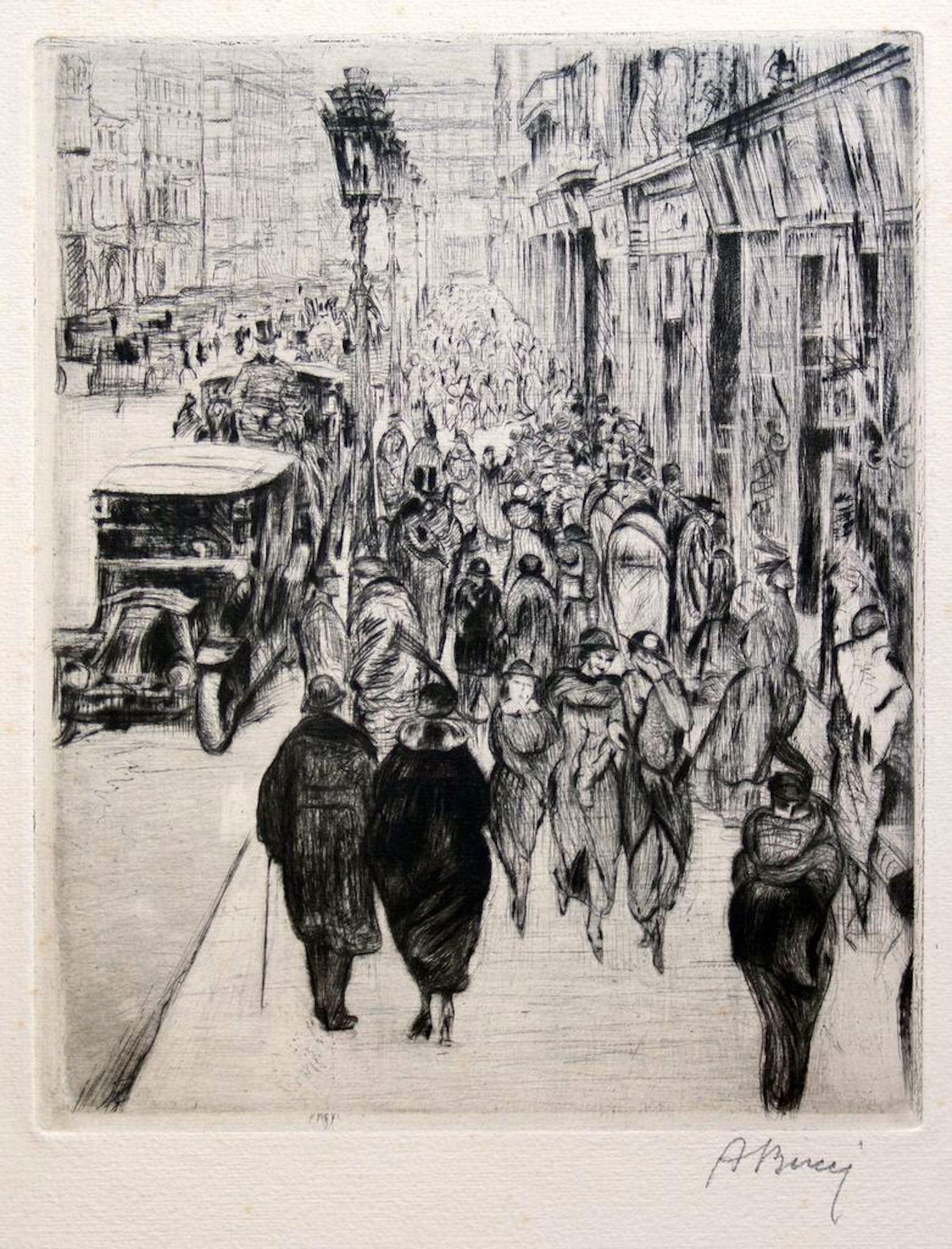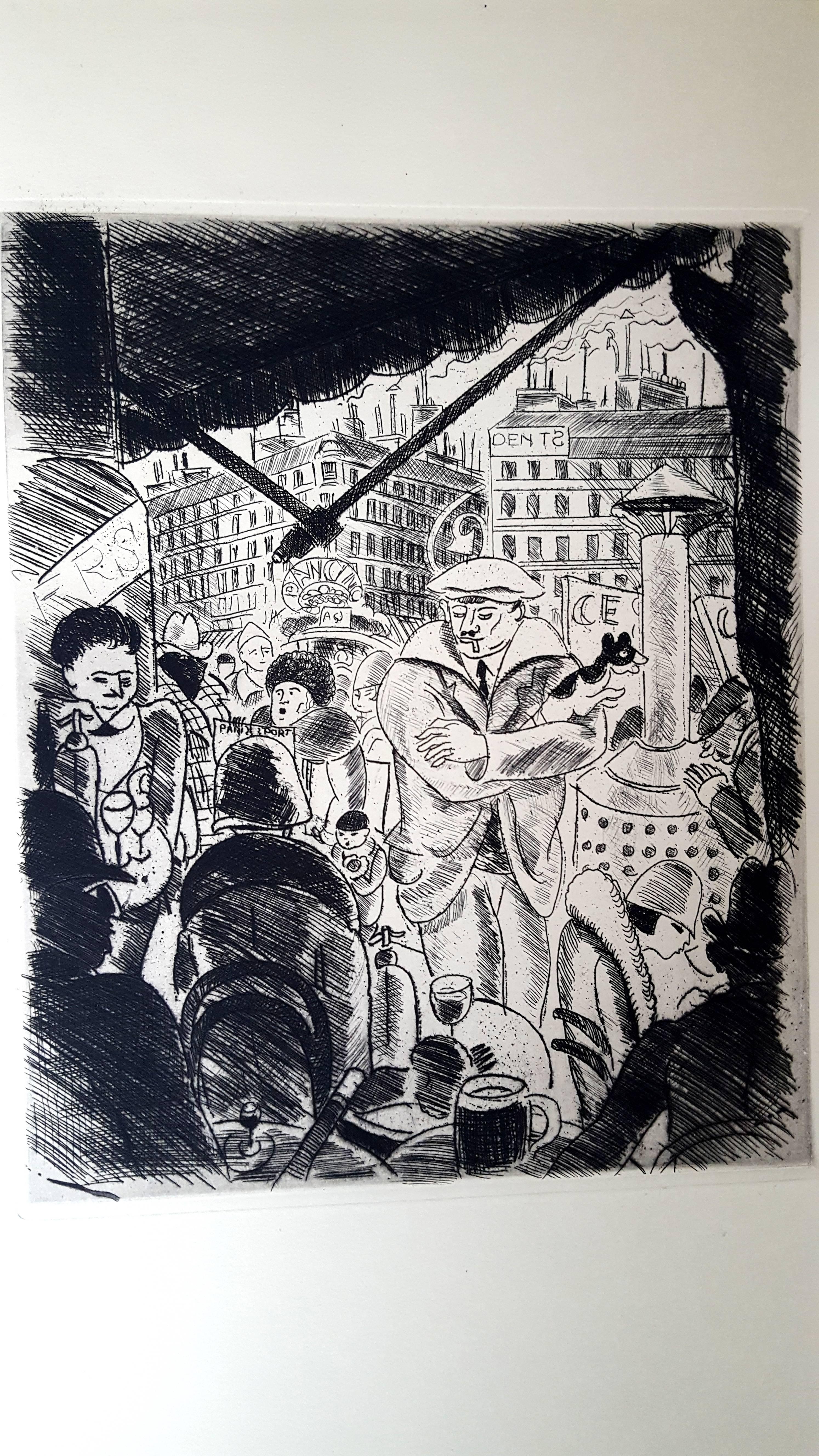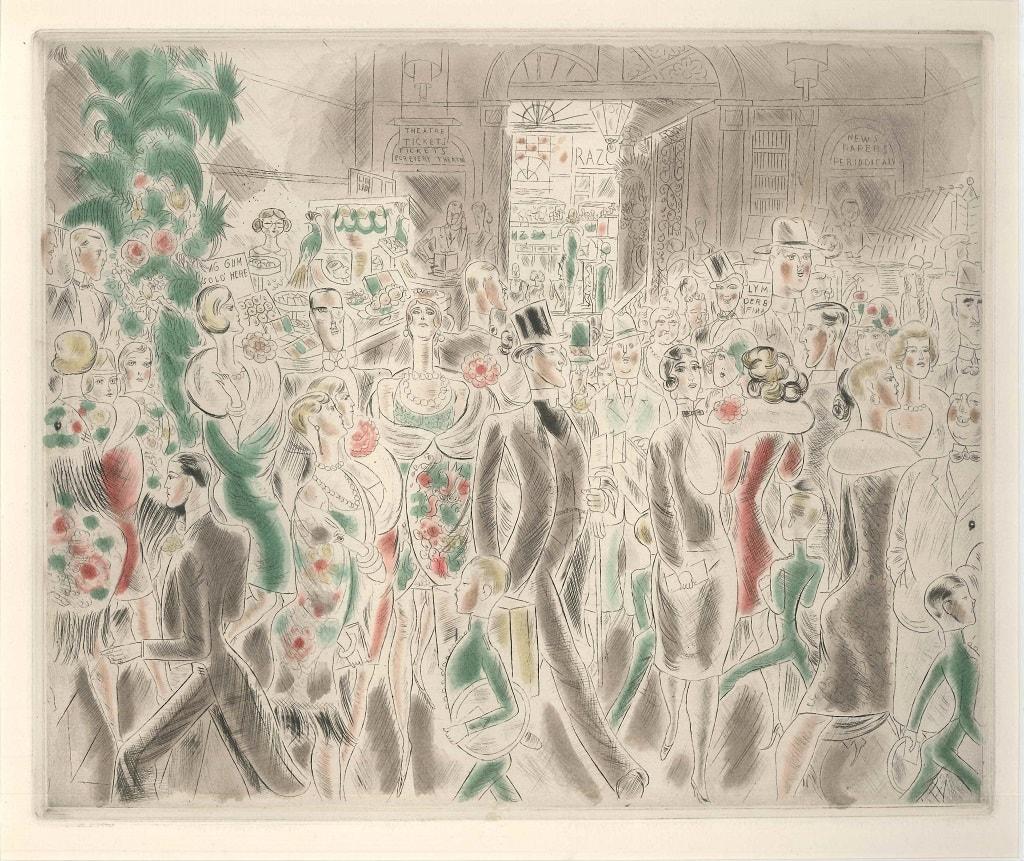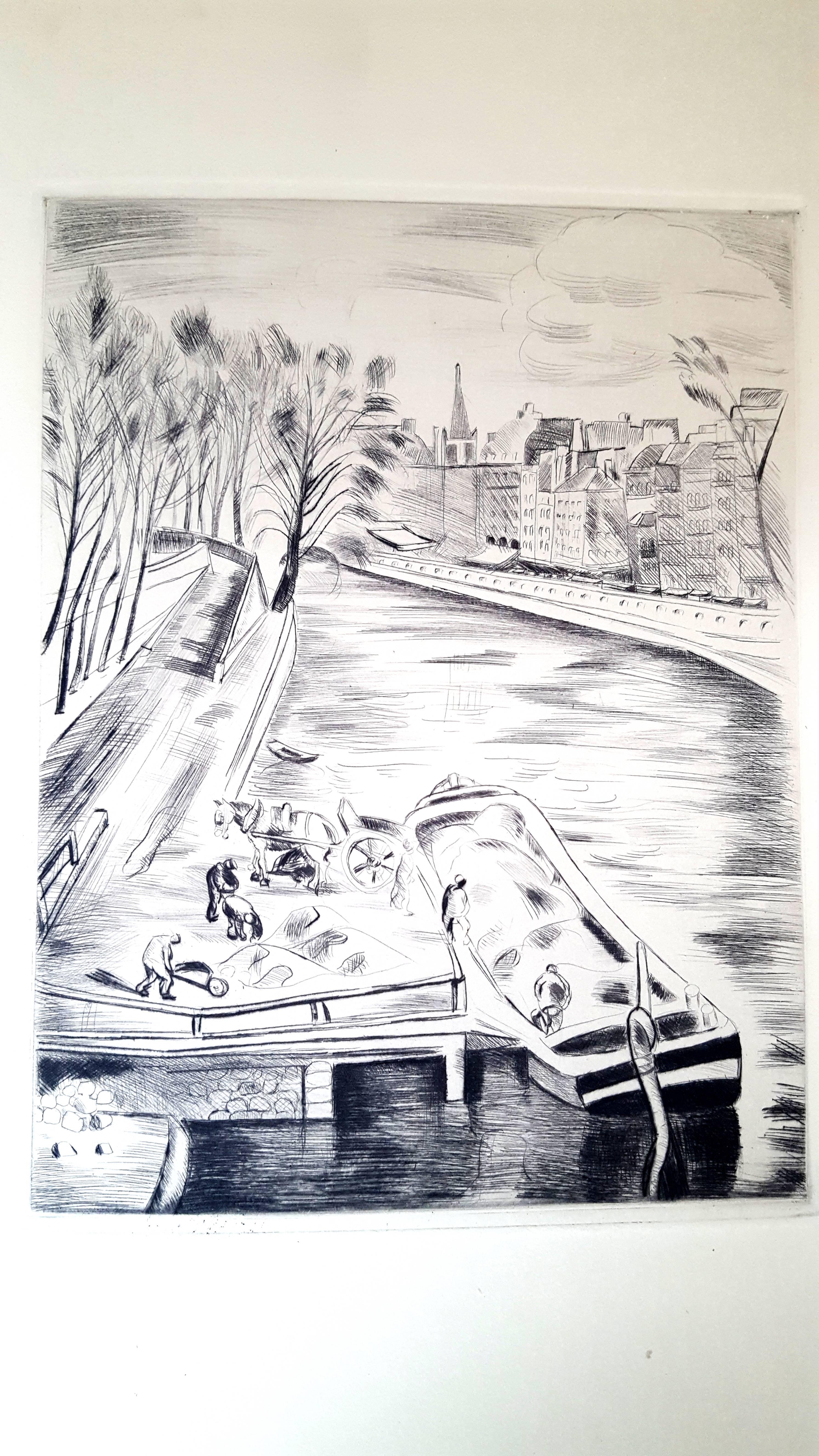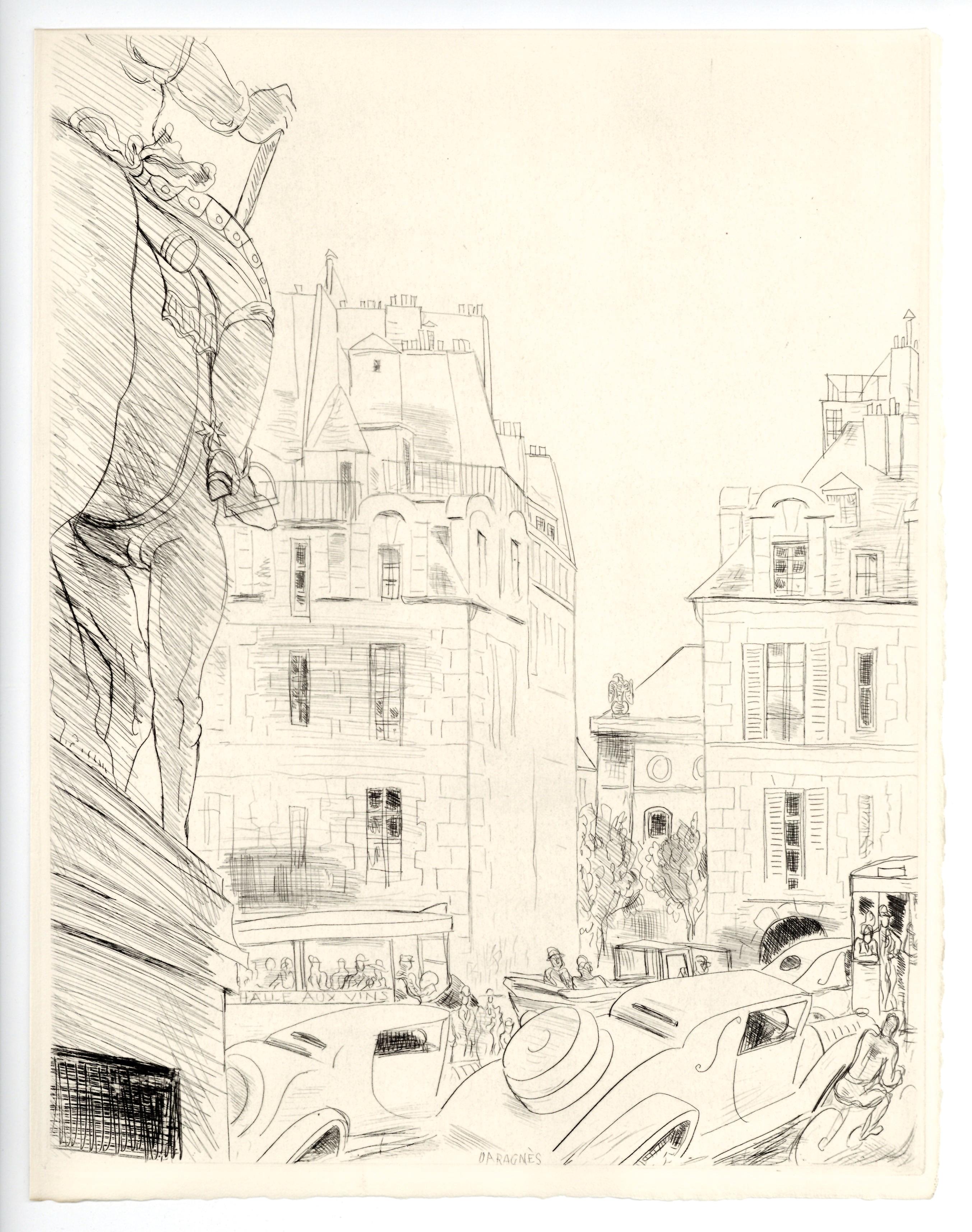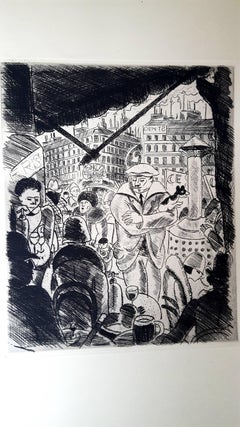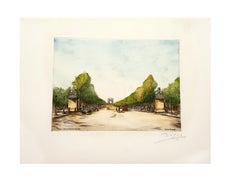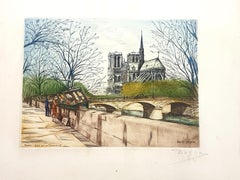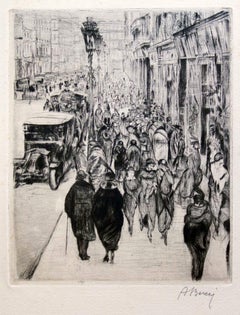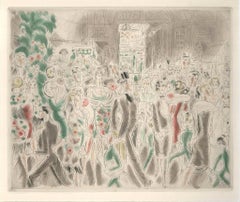Items Similar to Chas Laborde - Paris - Capucine's Boulevard - Original Etching
Want more images or videos?
Request additional images or videos from the seller
1 of 9
Chas (Charles) LabordeChas Laborde - Paris - Capucine's Boulevard - Original Etching1927
1927
$1,416.10
£1,076.15
€1,200
CA$1,989.69
A$2,181.64
CHF 1,140.50
MX$26,129.30
NOK 14,387.15
SEK 13,495.15
DKK 9,144.04
About the Item
Chas Laborde - Paris - Capucine's Boulevard - Original Etching
Dimensions : 13 x 10".
Paper : Rives vellum.
Edition : 225 copies.
1927
From Tableaux de Paris, Emile-Paul Freres, Paris
Chas LABORDE
Charles Laborde was born in Buenos Aires on August 8, 1886. He was the youngest of the five sons of Adolphe-Sylvestre Laborde-Pinou, a Basque-Bearne millionaire who had made a fortune selling spirits to the Indians and luxury goods imported from France to wealthy Argentines. The family returned to France when Charles was six months old. His mother died when he was two. He spent his childhood at their family château d’Escout outside Oloron-Sainte-Marie in the Pyrenees. His brothers went to a boarding-school, his father was often in Paris on business, and little Charles was left to his devices. Though it was a lonely childhood, he was a darling of his generous and magnanimous father. Charles got his early drawing skills from a village artist and found support in his brother Jean-Felix. Charles frequently accompanied his father visiting artisans and helped him choose de luxe objects to be sold in Argentine.
He first attended the Rollin college in Paris, then a lyceum in Pau, where he lived with full board and lodging after his father’s death in 1901. From childhood Charles wanted to be an artist and tried several pseudonyms for himself: Ch. Laborde, Carlos Laborde,Carlos Edrobal and Carl Lab. He started wearing a velvet suit and a large hat. At 17, the timid shortsighted teenager wearing big glasses was expelled from college for smoking and drinking alcohol and went to Paris into the custody of his elder brother Jean-Felix, who carried on his father’s business. Charles enrolled in the prestigious l’Académie Julian, studying under Henri Royer and Marcel Baschet. Simultaneously he was a pupil of William Bouguereau and Luc-Olivier Merson at l’École des Beaux-Arts. The latter was famous for being the designer of the 50 and 100 franc banknotes, and he believed that he was teaching a “little Daumier”.
In England, where he went every year from 1905 to 1914 with the family of his friend Cooper, a classmate at l’Académie Julian, he found not only his pseudonym Chas (short for Charley), but also the land of his dreams. Peculiarities of London and its inhabitants were reflected in drawings of William Hogarth and Thomas Rowlandson, whose album The Microcosm of London (1808) prompted Charles to make his London Streets Scenes (1928). Owing to those trips Charles took a liking to the atmosphere of England and its reserved and terse humor.
In 1905 the château d’Escout and the Buenos Aires Commercial Fund were sold. After coming into inheritance, Laborde became financially independent and obtained an atelier in Montmartre at 11 bis Rue des Saules. His neighbors were de la Butte, Francis Carco and Pierre Mac Orlan, who sympathized with the easy-going young man with a positive attitude to life. His friend Pierre Falke introduced the commencing artist to the labyrinth of the press world. Laborde took commissions from the satirical maganizes Le Rire, which way back in 1900 published one of his drawings, sent by him by post, and L’Assiette au Berre. In 1912 he moved to Le Sourire magazine and joined Gus Bofa.
At 21, Laborder chose to become a French citizen. When the First World War broke out, he, shortsighted, 162 cm tall and weighing 49 kg, without a shadow of doubt volunteered for the army, together with Apollinaire, Demetrios Galanis, Utter and Pierre Reverdy. The war ended for him after a gas attack in the spring of 1917. Convalescing Charles Laborde returned to Paris, feeling that three years had been crossed out of his life. He lost two brothers – Henri and beloved Jean-Felix – and also his good fortune, health and a host of illusions in that inglorious adventure. His good English friend Cooper too fell on the battlefield.
On February 8, 1915, a daughter, Iolanda, was born to Charles and his wife Rene Ferreau. On the frontlines Laborde took to drinking. Rene could not reconcile herself to his habit, their marriage got broken, and Charles left their apartment in Rue des Saules.
laborde2 Chas Laborde ★
Book art was born in the trenches. The French had never read as much as during the First World War. Books and magazines were of mediocre quality, printed on bad paper, which was in short supply. There appeared small publishers that printed texts by young authors with illustrations by young artists. For instance, books by Blaise Cendrars were decorated with drawings by Moses Kisling, Angel Zarraga and Raoul Dufy.
When the war ended, Charles Laborde continued to work for satirical magazines. Contributing to Le Rire Rouge and La Baïonnette, he depicted a special world of prostitution. Like the soldiers, young girls went about their business, which they despised, and just as stoically accepted its consequences. Charles exposed the hypocrisy of society.
“L’amie des filles,” as Carco called him, gave witness in their defense, lent them money and paid their debts. As a result, he ran out of money by 32. Carco persuaded his publishers to give him another chance and himself partially financed the publication of the book titled L’amie des filles. Gus Bofa exhibited Charles’ works at his Salon d’ Araignée, which he organized in 1920 to support graphic artists who had fought in WWI. Jean-Gabriel d’ Araignée, Charles Malexis and Pierre Mac Orlan founded a publishing house, La Banderole, and opened the door to book illustration for Laborde. In 1921 he was commissioned to illustrate Le Chat Maigre by Anatole France, who had just been awarded the Nobel Prize. Laborde opted for copper engravings.
Анри Жонкере Шарль Лаборд и Пьер Мак Орлан Chas Laborde ★
Henri Jonquirères, Charles Laborde and Pierre Mac Orlan
In 1924 Charles moved to the seventh floor of 121 in rue Caulaincourt. Unlike his former bohemian companions, he shuns any ostentation. A small suitcase, drawing tools that fit into the pocket of his jacket, and there he sets off for London or Berlin, which he loves so much, and where he makes sketches of local everyday life.
Three albums – Paris Street Scenes (1926), London Street Scenes (1928) and Berlin Street Scenes (1930) – testify to his immaculate gift. The anatomy of the three capitals is shown by him with his trademark scrutiny. The graphic sheets which Charles did after his return to his studio sum up the facial expressions, silhouettes and the color palette of the sketches he had done from nature. His works encompass every aspect of life – the beautiful and the ugly, the chaste and the vulgar, the funny and the horrible.
In 1930 JulesPascin committed suicide. He was a close friend, with whom Laborde had spent a lot of time together, making sketches and drawing book illustrations. Charles had to go back to reporting – he was commissioned to do a series of graphic reports. Devoid of any prejudice, he makes a brief journey to Moscow. As distinct from his other albums of the Street Scenes series, he himself wrote the text for his Moscow album. He saw the Reds treat their state benignly and haughtily take pride in their future, of which they had no doubts. He goes to Madrid at the height of Franco’s putsch and writes in his diaries that Spain is being engulfed in Civil War and filled with the smell of gunpowder.
The critic Charles Kunstler wrote that the artist saw everything around with fresh eyes, the eyes of a foreigner. We see the artist walking along the streets of New York, on Time Square and Coney Island. The album Streets and Views of New York was published after his death.
Candide sends him to Nazi Germany. Charles draws cartoons of Hitler and Mussolini lauding the triumph of war and death.
It should be noted that throughout his career Laborde did paintings as well, but they are far less known than his graphic works.
Unfortunately, Laborde’s career ended as sadly as it had started: he sold his drawings to the worst publications for 30 francs apiece.
Ailing and impoverished, he was shocked to hear the victorious march-past of Hitler’s troops through Paris streets. On December 30, 1941, Charles Laborde died from the lung disease caused by his exposure to gas and acid evaporations in the First World War. Just a few friends saw him to his grave at the Pere Lachaise Cemetery.
A year after Laborde’s death a large retrospective was mounted in Paris, and his drawings and engravings were shown in the Galliéra of Paris in 1976
- Creator:Chas (Charles) Laborde (1886 - 1941, Argentinian, French)
- Creation Year:1927
- Dimensions:Height: 13 in (33.02 cm)Width: 10 in (25.4 cm)Depth: 0.1 in (2.54 mm)
- Medium:
- Movement & Style:
- Period:
- Condition:
- Gallery Location:Collonge Bellerive, Geneve, CH
- Reference Number:1stDibs: LU16121831893
About the Seller
4.9
Gold Seller
Premium sellers maintaining a 4.3+ rating and 24-hour response times
Established in 2015
1stDibs seller since 2015
967 sales on 1stDibs
Typical response time: 1 hour
- ShippingRetrieving quote...Shipping from: Collonge Bellerive, Geneve, Switzerland
- Return Policy
Authenticity Guarantee
In the unlikely event there’s an issue with an item’s authenticity, contact us within 1 year for a full refund. DetailsMoney-Back Guarantee
If your item is not as described, is damaged in transit, or does not arrive, contact us within 7 days for a full refund. Details24-Hour Cancellation
You have a 24-hour grace period in which to reconsider your purchase, with no questions asked.Vetted Professional Sellers
Our world-class sellers must adhere to strict standards for service and quality, maintaining the integrity of our listings.Price-Match Guarantee
If you find that a seller listed the same item for a lower price elsewhere, we’ll match it.Trusted Global Delivery
Our best-in-class carrier network provides specialized shipping options worldwide, including custom delivery.More From This Seller
View AllPierre Falké - Paris' Terrasse - Original Etching
By Pierre Falké
Located in Collonge Bellerive, Geneve, CH
Pierre Falké - Paris' Terrasse - Original Etching
Dimensions : 13 x 10".
Paper : Rives vellum.
Edition : 225 copies.
1927
From Tableaux de Paris, E...
Category
1920s Modern Figurative Prints
Materials
Etching
Edmond Céria - Paris, Quais de Orfèvres - Original Etching
By Edmond Céria
Located in Collonge Bellerive, Geneve, CH
Charles Martin - The Eiffel Tower - Original Lithograph
Dimensions : 13 x 10".
Paper : Rives vellum.
Edition : 225 copies.
1927
From Tableaux de Paris, Emile-Paul Freres, Pari...
Category
1920s Modern Landscape Prints
Materials
Etching
Dufza - Paris - Champs Elysées - Original Handsigned Etching
Located in Collonge Bellerive, Geneve, CH
Dufza - Paris - Champs Elysées - Original Handsigned Etching
Circa 1940
Handsigned in pencil
Dimensions: 20 x 25 cm
Unumbered as issued
Category
1940s Modern Landscape Prints
Materials
Etching
Dufza - Paris - Quai de la Tournelle - Original Handsigned Etching
Located in Collonge Bellerive, Geneve, CH
Dufza - Paris - Quai de la Tournelle - Original Handsigned Etching
Circa 1940
Handsigned in pencil
Dimensions: 20 x 25 cm
Unumbered as issued
Category
1940s Modern Nude Prints
Materials
Etching
Dufza - Paris - Quai des Grands Augustins - Original Handsigned Etching
Located in Collonge Bellerive, Geneve, CH
Dufza - Paris - Quai des Grands Augustins - Original Handsigned Etching
Circa 1940
Handsigned in pencil
Dimensions: 20 x 25 cm
Category
1940s Modern Nude Prints
Materials
Etching
Moreau - Paris, At The Cinema - Original Etching
By Luc-Albert Moreau
Located in Collonge Bellerive, Geneve, CH
Moreau - Paris, At The Cinema - Original Etching
Dimensions : 13 x 10".
Paper : Rives vellum.
Edition : 225 copies.
1927
From Tableaux de Paris, Emile-Paul Freres, Paris
Category
1920s Modern Portrait Prints
Materials
Etching
You May Also Like
Paris 1920's : Animated Street near Bois de Boulogne - Original etching
By Chas Laborde
Located in Paris, IDF
Chas LABORDE
Paris 1920's : Animated Street near Bois de Boulogne
Original etching with aquatint
On vellum 44 x 56.5 cm (c. 17 x 22 in)
Edited by Chalcogra...
Category
Late 20th Century Modern Figurative Prints
Materials
Etching
Downtown Paris - Etching by Anselmo Bucci - 1915 ca.
By Anselmo Bucci
Located in Roma, IT
Hand signed.
Very good conditions.
Category
1910s Figurative Prints
Materials
Drypoint, Etching
From Rues et Visages de Paris - 1920s - Drypoint/Etching - Modern
By Chas Laborde
Located in Roma, IT
Illustrated Plate, from Rues et Visages de Paris is a hand-colored etching and drypoint by Chas Laborde. This original print is hand-colored with tempera and watercolor.
In excellent...
Category
1920s Modern Figurative Prints
Materials
Tempera, Watercolor, Drypoint, Etching
"Presence de Paris" original etching
Located in Henderson, NV
Medium: original etching. This impression on Canson et Montgolfier wove paper was printed in 1937 in an edition of 500 for the "Paris 1937" portfolio. Printed at the atelier of Jean-...
Category
1930s Prints and Multiples
Materials
Etching
Paris - Original Etching by A. Buratti - 1947
By Armando Buratti
Located in Roma, IT
Image dimensions: 24 x 27 cm.
Paris is an original artwork realized in 1947 by Armando Buratti.
Original black and white etching.
Hand-signed and dated in pencil on lower right. N...
Category
1940s Contemporary Landscape Prints
Materials
Etching
Amicalement - from Rues et Visages de Paris - Drypoint/Etching - 1920s - Modern
By Chas Laborde
Located in Roma, IT
Amicalement is a hand-colored etching and drypoint, signed by Chas Laborde on the lower right margin. Hand-titled on the lower left margin. This original print is hand-colored with t...
Category
1920s Modern Figurative Prints
Materials
Drypoint, Etching, Tempera, Watercolor
